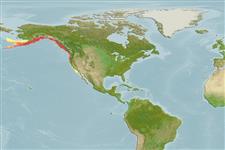Asteroidea |
Forcipulatida |
Asteriidae
Environment: milieu / climate zone / गहराई सीमा / distribution range
पारिस्थितिकी
; गहराई सीमा 0 - 240 m (संदर्भ 865). Temperate
Eastern Pacific: Alaska, USA and Canada.
Length at first maturity / आकार / Weight / Age
परिपक्व अवधि: Lm ? range ? - ? cm Max length : 38.0 cm WD पुल्लिंग / अलिंग; (संदर्भ 865)
It is found on rocky and soft bottoms from the very low intertidal to a depth of 240 meters (Ref. 865).
Life cycle and mating behavior
परिपक्व अवधि | पुनरुत्पत्ति | मछलीऔ का अंडे देना | Eggs | Fecundity | Larvae
Members of the class Asteroidea exhibit both asexual (regeneration and clonal) and sexual (gonochoric) means of reproduction. Life cycle: Embryos hatch into planktonic larvae and later metamorphose into pentamorous juveniles which develop into young sea stars with stubby arms.
Gotshall, D.W. 2005 Guide to marine invertebrates: Alaska to Baja California, 2nd ed. (revised). Sea Challengers. 117 p. (संदर्भ 865)
IUCN Red List Status
(संदर्भ 130435: Version 2025-1)
CITES status (संदर्भ 108899)
Not Evaluated
CMS (संदर्भ 116361)
Not Evaluated
Threat to humans
Human uses
| FishSource |
साधन
अधिक जानकारी
Population dynamicsबाढ़
Max. ages / sizes
Length-weight rel.
Length-length rel.
Length-frequencies
Mass conversion
बहुतायत
Life cycleपुनरुत्पत्तिपरिपक्व अवधिFecundityमछलीऔ का अंडे देनाEggsEgg developmentLarvae PhysiologyOxygen consumption
Human RelatedStamps, coins, misc.
इंटरनेट स्रोत
Estimates based on models
Preferred temperature
(Ref.
115969): 4.2 - 9.7, mean 6.5 (based on 180 cells).
Fishing Vulnerability
Low to moderate vulnerability (28 of 100).
Price category
Unknown.
